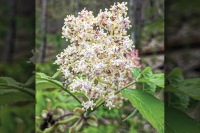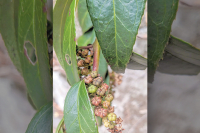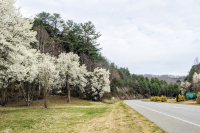The Joyful Botanist: Rowan on a mountain
 Most prefer to use the more common of its common names, mountain-ash, to describe this small tree. Adam Bigelow photo
Most prefer to use the more common of its common names, mountain-ash, to describe this small tree. Adam Bigelow photo
At the higher elevations in the Southern Appalachian Mountains grows a special and sacred tree whose red berries glow in the full sun against a clear blue-sky. Steeped in folklore and traditions brought by European settlers and colonizers, the sight of the rowan tree (Sorbus americanus) must have filled the hearts of Scotch and Irish descendants with nostalgia for home.
Most prefer to use the more common of its common names, mountain-ash, to describe this small tree. It was given this name due to the similarities of its leaves to those of ash trees (Fraxinus spp.) The compound leaves of the rowan look much more similar to those of sumacs (Rhus spp.) than they do to ash trees. This, plus the celebration of my own Irish and Celtic roots lead me to use rowan as my preferred name for Sorbus americanus.
A leaf is described as compound when it is divided into multiple leaflets that separate from the main, middle vein of the leaf. This is in contrast to simple leaves that have no separations and grow as a single leaf from the stem. Compound leaves can have different forms, and the leaflets can have their own stalk, or petiole, or they can be stalkless or sessile in their attachment. A palmately compound leaf, like yellow buckeye (Aesculus flava.) have leaflets that radiate from a central point and resemble the palm of your hand. Hence, the term palmate.
The rowan tree’s leaves are pinnately compound, which is where the leaflets are arranged along the middle vein — or midrib — in alternate or more commonly in opposite arrangement. Pinnately compound leaves often have a terminal leaflet at the point, or end of the leaf as is the case with the rowan tree.
It is the flowers, and especially the vivid fruits, that make this a very showy and beautiful tree. The flowers are white and urn shaped and are displayed in a form called a corymb. A corymb is where the flower stalk, or pedicel, of the outermost lowers are longer than those in the middle, giving the flower cluster a flat and open shape which resembles a candelabra.
Once pollinated, the fruits begin to ripen and take on a strong red to orange hue holding lots of berries in the corymb cluster. These fruits are stunning and will remain on the tree well into winter. They look incredible not only against a blue-sky backdrop but also standing out as a compliment to the yellow fall color that the leaves take on once their photosynthetic work is done for the year.
Related Items
The fruits of the rowan tree provide good nutrition to birds and other animals through early winter. While edible to humans, they do not taste very good. However, they are loaded with natural fruit pectin and can be combined with other tasty fruits to make a good jelly or jam, helping the jelly to set without the need for additional pectin.
I encourage you to get yourself up onto the Blue Ridge Parkway or into the Smokies to see the magical display of this most special tree. They don’t always have a good fruiting year, but this year is spectacular, and the rowan tree is ready to fill you with awe and inspire or deepen your connection with the sacred. I especially enjoy seeing the rowan in fruit in Roan Highlands. What could be better than seeing a rowan on the Roan?
(The Joyful Botanist leads weekly wildflower walks most Fridays and offers consultations and private group tours through Bigelow’s Botanical Excursions. This email address is being protected from spambots. You need JavaScript enabled to view it..)













